History, Art & Culture: May 2024 UPSC Current Affairs | Current Affairs & Hindu Analysis: Daily, Weekly & Monthly PDF Download
Racial Bias in Jallianwala Bagh Massacre Compensation
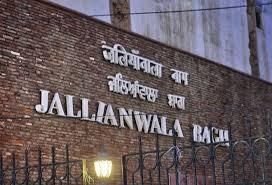
Why in News?
New research reveals how the British government used a highly racialized legal framework to compensate those affected by the Jallianwala Bagh massacre, a tragic event on April 13, 1919, which stands as a grim milestone in India's colonial past.
Key Highlights of the Research
- Racial Bias in Compensation:
- The British government's compensation heavily favored Europeans over Indians.
- Europeans received compensation amounts that were 600 times higher than those given to Indians.
- British authorities allocated over Rs. 523,000 in compensation to Europeans, with individual payments ranging from Rs. 300,000 to Rs. 30,000.
- Discriminatory compensation underscores racial prejudice and a devaluation of Indian lives.
- Legal Proceedings:
- The Punjab Disturbances Committee was divided along racial lines, justifying British officers' violent actions.
- European members of the committee justified the aggressive tactics employed by British officers in Punjab, while Indian members dissented.
- Indian legislators demanded equitable compensation but faced resistance from British officials.
- Unfairness of Colonialism:
- Recent research amplifies calls for a formal apology from the British government.
- Advocates for the decolonization of historical injustices and acknowledgment of imperial legacies.
What is the Jallianwala Bagh Massacre?
- Prelude to the Massacre:
- The Indian National Congress anticipated self-governance post-World War I but encountered resistance from the Imperial bureaucracy.
- The Rowlatt Act of 1919 authorized arrests without trial for individuals linked to seditious activities, sparking nationwide unrest.
- The arrests of nationalist leaders Saifuddin Kitchlew and Dr. Satyapal on April 9, 1919, triggered widespread protests in Punjab.
- The Massacre:
- The Jallianwala Bagh massacre occurred amidst heightened tensions due to the oppressive Rowlatt Act and widespread protests in Punjab.
- Fearing a rebellion akin to the 1857 revolt, the British administration responded with harsh repression.
- Brigadier-General Dyer's troops opened fire indiscriminately on April 13, 1919, during a peaceful protest against the Rowlatt Act, resulting in the deaths of hundreds of innocent protestors.
- Dyer issued a proclamation on Baisakhi, April 13, forbidding movement without passes and demonstrations.
- Hunter Commission:
- The Hunter Commission, formally titled the "Punjab Disturbances Inquiry Committee," was established by the British government following the Jallianwala Bagh massacre.
- The commission's report criticized Dyer's decision to fire upon unarmed civilians and highlighted the disproportionate use of force.
- These findings contributed to widespread condemnation of Dyer's actions in India.
- Prior to the committee's proceedings, the government enacted an Indemnity Act to shield its officers.
- The commission's report led to Dyer being relieved of his command and retiring from the military.
- Aftermath and Significance:
- The Jallianwala Bagh massacre became a pivotal moment in India's independence movement, sparking Mahatma Gandhi's Non-Cooperation Movement (1920-22).
- Rabindranath Tagore renounced his knighthood in protest against the massacre.
- In 1940, Indian freedom fighter Udham Singh assassinated Michael O'Dwyer, who had approved of Dyer's actions, at Caxton Hall in London.
Hoysala’s Sri Madhava Perumal Temple Reveals Trade Route
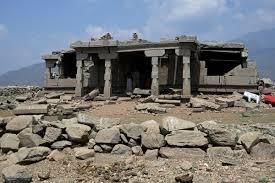
Why in News?
Recently discovered inscriptions at Sri Madhava Perumal Temple suggest the presence of a significant trade route more than 1,000 years ago, linking the Kongu region in western Tamil Nadu with southern Karnataka and Kerala.
Key Facts About the Madhava Perumal Temple
About:
- Dedicated to the Hindu deity Vishnu, worshipped as Madhava Perumal, the temple is situated in Mylapore, Chennai, Tamil Nadu.
- Mylapore was under the rule of the Hoysala dynasty, notably King Veera Ballala III.
- The Dhandanayaka Fort, constructed by the general of the Hoysala army 680 years ago, housed the temple built in the Dravidian style of architecture.
- Later, the region was governed by the Vijayanagara Empire and Tipu Sultan.
- The Battle of Sathyamangalam (1790) occurred near the fort during the Third Anglo-Mysore War (1790-1792).
- The temple is believed to be the birthplace of Peyalvar, one of the first three Alvar saints of the 6th-9th century CE.
- Submerged for years in the waters of the Bhavanisagar dam in Erode district, the temple emerged when the dam's water level receded.
Temple Inscription:
- Inscriptions discovered revealed the presence of Thuravalur village.
- The area served as a major trade route, connecting traders who crossed River Bhavani and River Moyar to reach Wayanad in Kerala and various locations in Karnataka.
- The construction of the Bhavanisagar dam in 1948 led to the relocation of nearby residents and the shifting of temple idols to new locations in 1953.
Key Facts about Hoysala Dynasty
Origin and Rise
- The Hoysalas were feudatories of the Chalukyas of Kalyana, or the Western Chalukya Empire.
- The first kings came from the hills northwest of Dorasamudra (present-day Halebid), which became their capital in 1060 AD.
- The most notable rulers of the Hoysala dynasty were Vishnuvardhana, Veera Ballala II, and Veera Ballala III.
- Vishnuvardhana (also known as Bittideva) was the greatest king of the Hoysala dynasty.
- They governed areas spanning Karnataka and Tamil Nadu in the Kaveri (Cauvery) river valley between the 11th- 14th century.
- Later, the Vijayanagar dynasty succeeded the Hoysalas.
Religion and Culture
- The dynasty patronised various religions, such as Hinduism, Jainism, and Buddhism.
- King Vishnuvardhana was initially a Jain but later converted to Vaishnavism under the influence of the Saint Ramanuja.
Temple Architecture
- The Hoysala Temples were built during the 12th and 13th centuries CE, showcasing the unique architectural and artistic brilliance of Vesara style.
- Among Hoysala temples, Chennakeshava Temple in Belur, Hoysaleshwara Temple in Halebid, Keshava Temple of Somanathapur are UNESCO World Heritage Sites and protected by Archaeological Survey of India (ASI).
- Hoysala architecture is known for its distinctive blend of Bhumija style prevalent in Central India, the Nagara traditions of northern and western India, and the Karnataka Dravida modes favoured by the Kalyani Chalukyas.
- These contain multiple shrines grouped around a central pillared hall and laid out in the shape of an intricately designed star.
- They are made out of soapstone which is a relatively soft stone, the artists were able to carve their sculptures intricately.
Centenary of the Vaikom Satyagraha
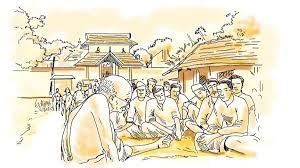
Why in News?
India recently observed the 100th anniversary of the Vaikom satyagraha, a significant movement in Indian history that confronted untouchability and caste discrimination.
What is Vaikom Satyagraha?
- Background:
- Vaikom Satyagraha, a nonviolent agitation, unfolded in Vaikom within the princely state of Travancore, Kerala precisely a century ago spanning from 30th March 1924 to 23rd November 1925.
- This movement stood as a formidable protest against the entrenched practices of untouchability and caste discrimination that had long plagued Indian society.
- The movement was triggered by the prohibition of people from oppressed classes, especially Ezhavas, from walking on the roads surrounding the Vaikom Mahadeva temple.
- Efforts were made to negotiate with authorities, including Maharani Regent of Travancore, to open temple roads.
- It was the first among the temple entry movements in India, setting the stage for similar movements across the country.
- It emerged amidst the growing nationalist movement and aimed to foreground social reform alongside political aspirations.
- Key Figures:
- It was led by visionary leaders like Ezhava leader T K Madhavan, K.P. Kesava Menon, and K. Kelappan.
- Erode Venkatappa Ramasamy, revered as Periyar or Thanthai Periyar, played a crucial role, mobilising volunteers, delivering speeches, and enduring imprisonment, earning the title 'Vaikom Veerar'.
- The movement gained more power when Mahatma Gandhi reached Vaikom in March 1925 and held discussions with leaders of various caste groups.
- Strategies and Initiatives:
- The satyagraha initially focused on opening the roads surrounding the Vaikom temple to people from all castes.
- Leaders of the movement strategically chose nonviolent methods, inspired by Gandhian principles of protest.
- Outcome:
- The Vaikom Satyagraha led to significant reforms, including the opening of three out of four roads surrounding the temple to people of all castes.
- Aftermath and Legacy:
- In November 1936, the Maharaja of Travancore signed the historic Temple Entry Proclamation, which removed the age-old ban on the entry of marginalised castes into the temples of Travancore.
- The Vaikom Satyagraha led to a division in perspectives, with few viewing it as a Hindu reformist movement, while another saw it as a fight against caste-based atrocities.
- Memorials, including the Vaikom Satyagraha Memorial Museum and Periyar's Memorial, were established to commemorate the movement's significance.
Ahobilam Temple
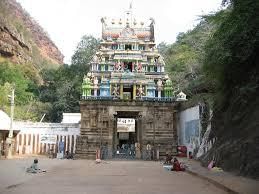
Why in News?
Recently, visitor restrictions have been implemented at Ahobilam by the Forest Department and Sri Lakshmi Narasimha Swamy Devasthanam (SLNSD) due to the shrine's location within the Nallamala forest, which encompasses nine distinct temples.
Ahobilam Temple
- About: It is located in the Kurnool District of Andhra Pradesh and is counted among the 108 Vaishnava Divyadesams.
- Temples of Ahobilam: The region is famous for two temples situated in Lower Ahobilam and Upper Ahobilam.
- Mythological Significance: According to local legend, Ahobilam is where Lord Narasimha, an incarnation of Lord Vishnu, blessed Prahlada and slayed Hiranyakashipu.
- Ahobilam Narasimha Temple: This temple is the primary and oldest among the nine temples in Ahobilam.
Nagarjunasagar-Srisailam Tiger Reserve (NSTR)
- About: It is the largest tiger reserve in India.
- Declared: Tiger reserve in 1983, NSTR covers 3,727.82 sq km, encompassing core and buffer areas.
- Role of Ahobilam National Tiger Conservation Authority: NTCA, formed under the Wildlife Protection Act of 1972, oversees rare flora and fauna, particularly around the Pavana Narasimha temple area, which is habitat to red sanders, leopards, deer, and five tigers.
- Vegetation: Tropical dry deciduous forests
- Restrictions: They are imposed due to the intense heatwave to ensure the safety of wild animals, including a ban on plastic usage, with designated deposition points at the Cheethal base camp.
- Prohibition: Overnight stays are prohibited to mitigate man-animal conflict, especially with nocturnal animal movements.
Rakhigarhi Findings in NCERT Books Added
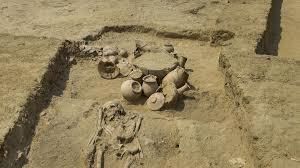
Why in News?
The National Council of Educational Research and Training (NCERT) has proposed revisions in school textbooks, including new insights from DNA analysis of skeletal remains found at the archaeological site of Rakhigarhi in Haryana.
More information from the news
- According to NCERT, analysis of ancient DNA from Rakhigarhi suggests that the genetic origins of the Harappans date back to 10,000 BCE.
- The genetic legacy of the Harappans persists in the majority of South Asian populations today.
- The genetic makeup shows minor gene flow due to trade and cultural exchanges with distant regions.
- The continuous genetic and cultural history of the Harappans refutes the idea of large-scale immigration by the so-called Aryans.
- Research indicates that people from neighboring and distant regions were assimilated into Indian society.
- The genetic history of Indians shows uninterrupted continuity throughout its stages.
- As the Harappans migrated towards Iran and Central Asia, their genetic influence extended to these regions.
- Reconstructed facial features of Harappan males and females bear striking resemblance to modern populations in Haryana, indicating uninterrupted continuity in this region for 5000 years.
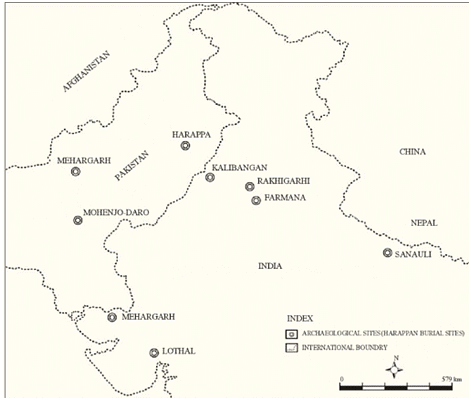
About Rakhigarhi
- Rakhigarhi, situated in Hisar, Haryana, is one of the largest townships of the Harappan Civilization and ranks among the largest sites of the Indus Valley Civilization.
- The site comprises five interconnected mounds spread over a vast area, making it distinctive.
- Amarendra Nath from the Archaeological Survey of India led the excavation of Rakhigarhi.
- Rakhigarhi showcases evidence of the early, mature, and late phases of the Indus Valley Civilization.
- The settlement includes dwellings made of mudbrick and burnt-brick, featuring an advanced drainage system.
- The ceramic industry at Rakhigarhi produced red ware such as dish-on-stand, vases, jars, bowls, beakers, perforated jars, goblets, and pans (handis).
- Excavations unearthed various artifacts including blades, terracotta and shell bangles, beads made of semi-precious stones, terracotta, shell, and copper objects, animal figurines, toy cart frames and terracotta wheels, bone points, inscribed steatite seals, and sealings.
- The necropolis at Rakhigarhi yielded extended burials from a late phase, possibly from medieval times, including a rare double burial of a male and female.
- Evidence of the Harappan ritual system includes animal sacrificial pits lined with mud brick and triangular and circular fire altars on mud floors.
- A significant find from Rakhigarhi is a cylindrical seal with five Harappan characters on one side and an alligator symbol on the other.
- Archaeologists have discovered what appears to be a workshop for jewellery making at the site.
Harappan Civilisation
- The Harappan civilization, also known as the Indus Valley Civilization, is considered the beginning of Indian history.
- It can be divided into three phases:
- Early Harappan Phase from 3200 to 2600 BCE.
- Mature Harappan Phase from 2600 to 1900 BCE.
- Late Harappan Phase from 1900 to 1700 BCE.
- The early Harappan phase marked the transition towards the mature Harappan period.
- During this phase, farmers from the highlands gradually migrated between their mountain residences and the lowland river valleys.
- The earliest specimens of the Indus script date back to the third millennium BCE, and trade networks connected this civilization to other regional cultures and distant sources of raw materials.
- By this time, the villagers had successfully cultivated a diverse range of crops such as peas, sesame seeds, dates, and cotton. Additionally, they also domesticated animals like the water buffalo.
- By 2600 BCE, early Harappan villages had developed into major urban centres, signalling the beginning of the mature Harappan phase.
Societal Features
- The society of the IVC displayed distinct urban characteristics, organized into three primary segments:
- an affluent elite residing in the fortified citadel region.
- a prosperous middle class consisting of merchants.
- a less privileged segment comprising laborers dwelling in the lower areas of the cities.
- This societal structure was underpinned by a complex division of labor, leading to a diversified and stratified community comprising scholars, artisans, traders, warriors.
- Evidence from archaeological findings suggests that the Indus Valley Civilization had a significant reverence for the feminine aspect of divinity, indicative of a matriarchal influence.
- Abundance of terracotta female figurines discovered across various sites, symbolizing the respect of the Great Mother Goddess.
- Garments within the IVC were crafted from diverse materials such as cotton, silk, and wool.
- Furthermore, the presence of woven cloth at the Great bath in Mohenjodaro suggests a sophisticated understanding of spinning and weaving among the inhabitants.
- The Civilization IVC relied predominantly on copper and bronze, with no knowledge of iron usage at the time.
- Copper was primarily sourced from the Khetri copper mines in Rajasthan, while tin likely originated from Afghanistan.
- Harappans possessed minimal armaments and weaponry. Instead, their focus lay on technological and cultural pursuits.
- The presence of massive brick structures across various sites indicates a specialized class of masons and underscores the significance of brick-laying as a vital craft in civilization.
- People engaged in a diverse area of crafts, including boat-making, bead-making, and seal-making.
- Excavations at sites such as Chanhudaro and Lothal have revealed workshops dedicated to bead-making.
- Seals, primarily crafted from steatite, were a prominent feature of IVC culture.
- While many seals were fashioned from steatite, others were crafted from materials such as gold, ivory, chert, and agate.
- Played a crucial role in trade activities, serving as markers of authenticity and authority in commercial transactions.
Polity
- Conclusive evidence is lacking.
- Some scholars suggest that the absence of clear evidence implies a society where all individuals enjoyed equal status, without centralized rulership.
- Conversely, another perspective explains the presence of multiple rulers, each representing different urban centres, rather than a single overarching authority.
- However, the remarkable uniformity in tools, weapons, brickwork, seals, and urban architecture hints at the potential existence of a centralized political authority.
- The planning evident in street layouts, sophisticated drainage systems, and citadels suggests the presence of a robust central government overseeing urban planning and administration.
- This authority might have been wielded by a class of merchants, which is supported by the notable absence of temples in Indus Valley Civilization sites.
- However, it’s essential to acknowledge that without any conclusive evidence, the precise nature of political organization in the Indus Valley Civilization is open to interpretation.
Economy
- Agriculture in the Indus Valley Civilization:
- Favorable climatic conditions and fertile land supported thriving agriculture in the IVC.
- Crops cultivated included rice, wheat, cotton, barley, dates, melons, peas, lentils, mustard, linseed, sesamum, ragi, bajra, and jowar.
- Rainfed agriculture predominated, relying on seasonal rains for irrigation.
- Agricultural artifacts like the wooden plough in Kalibangan (Rajasthan), the granary in Mohenjodaro (Pakistan), and evidence of barley cultivation in Banawali (Rajasthan) highlight the importance of agriculture in the civilization.
- The Indus people were pioneers in cotton cultivation and utilized bulls and oxen for ploughing.
- Trade and Economic Activities:
- The Harappans engaged in extensive trade involving stone, metals, and shells within and beyond their region.
- Trade routes facilitated both inter-regional and intra-regional commerce.
- Unlike metal currency, trade in the IVC operated on a barter system.
- Maritime trade routes along the Arabian Sea coast were maintained by the IVC, with a trading outpost established in northern Afghanistan for trade with Central Asia.
- Economic ties extended to regions such as the Tigris and Euphrates, Mesopotamia, and Persia, as evidenced by Mesopotamian records mentioning trade relations with ‘Meluha’ (the ancient name for the Indus region) and trading ports like ‘Dilmun’ and ‘Makan’.
- Mesopotamians imported copper, ivory, pearls, and ebony from Meluha and exported garments, perfumes, leather goods, and silver to the IVC.
Satpula Dam

Why in News?
Delhi’s oldest surviving Satpula dam, which was built during the 14th-century, still stands strong.
About Satpula Dam
- Satpula (‘sat’ means seven and ‘pull’ means openings of a bridge) was constructed during the reign of Sultan Muhammad Shah Tughlaq (1325-1351).
- This structure was built using Delhi quartz — a stone found in the Aravallis.
- It was developed as an integral component of the defence wall of the fourth city of Delhi, Jahanpanah.
- The dam served two purposes: Providing a reliable source of water for irrigation, and acting as a defence against possible intruders.
- It was developed by identifying appropriate topography, i.e., a large open plain where water can be stored for irrigating large flat lands. Hence, this structure with sluice gates and a reservoir was developed.
- Since Sufi saint Nasiruddin Mahmud (popularly known as Chirag Dehlavi) used to live nearby, people used to believe that the canal water had healing properties.
- For centuries, the area used to host a Diwali mela and the attendees would take a holy dip in the waters and even collect some to take home.
Phanigiri
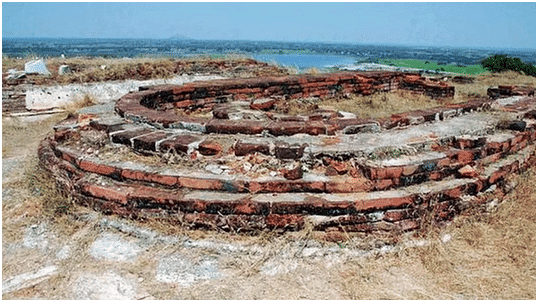
Why in News?
The Department of Archaeology and Museums recently uncovered a coin hoard at Phanigiri in Suryapet district, Telangana.
About Phanigiri
- Phanigiri is a renowned Buddhist site situated 110 km from Hyderabad.
- The site derives its name from the shape of the hillock resembling a snake hood, with 'Phani' meaning snake and 'Giri' meaning hillock in Sanskrit.
- It is considered a significant Buddhist monastery strategically positioned on the ancient trade route (Dakshinapatha) linking the west and east coasts of the Deccan.
Other findings of the excavation
- Coins: Lead coins featuring an elephant symbol on one side and the Ujjain symbol on the other side have been discovered.
- Archaeologists date these coins to the Ikshvaku period, ranging from the 3rd to 4th centuries Common Era.
- Additional artifacts unearthed include stone beads, glass beads, fragments of shell bangles, stucco motifs, broken limestone sculptures, a wheel from a toy cart, final nails, and pottery.
- The excavation also revealed architectural features such as the Mahastupa, apsidal Chaityagrihas, Votive stupas, pillared congregation halls, Viharas, platforms with staircases at different levels, octagonal stupa chaitya, 24-pillared mandapam, circular chaitya, and various cultural materials such as terracotta beads, semi-precious beads, iron objects, Brahmi label inscriptions, and a holy relic casket.
- All these cultural artifacts date back from the 1st century BCE to the 4th century CE.
Science Behind Surya Tilak Ceremony
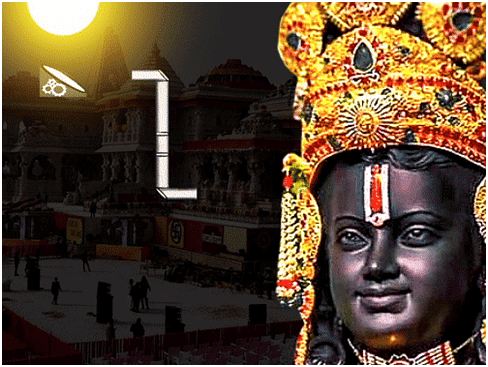
Why in News?
On the occasion of Ram Navami, 'Surya Abhishek' of Ram Lalla in Ayodhya temple was held precisely at noon for about three minutes on April 17.
Surya Tilak or Surya Abhishek
- Surya Tilak or Surya Abhishek involves directing a ray of sunlight onto the idol's forehead on a specific day, in this case, Ram Navami, which marks the believed birthday of Lord Ram falling typically in March or April.
- This Ram Navami was the first since the consecration of the Ram idol at the new temple on January 22. The system underwent testing by scientists on Tuesday.
- The planned size of the tilak is 58 mm, lasting slightly over three minutes, with around two minutes of full illumination.
Developed by CBRI
- The design, developed in collaboration with the Indian Institute of Astrophysics (IIA), Bangalore, was executed by the CSIR-CBRI team from Roorkee. They designed a mechanism ensuring sunlight reaches the 'Garbha Griha' for 19 years, spanning from the temple's third floor.
- Optics and Allied Engg Pvt Ltd (Optica), a company based in Bangalore, fabricated the optical elements, pipes, tilt mechanism, and related components.
- Trials and installation were completed by the CSIR-CBRI, Roorkee team in early April, alongside ongoing repeated trials.
What is an opto-mechanical system?
- The opto-mechanical system incorporates four mirrors and four lenses integrated into tilt and piping systems.
- An aperture on the top floor covers the tilt mechanism, directing sunlight through mirrors and lenses into the garbhagriha.
- The final lens and mirror focus sunlight onto the forehead of Shri Ram, facing east.
- A tilt mechanism adjusts the first mirror to direct sunlight northward towards the second mirror, ensuring the annual Surya Tilak on Ram Navami.
- All components, including piping, are crafted from durable brass, while mirrors and lenses are of high quality to ensure longevity.
- Internal surfaces of pipes, elbows, and enclosures are coated with black powder to prevent sunlight scattering.
- An IR filter glass at the aperture restricts heat waves from reaching the idol's forehead.
World Craft City Programme
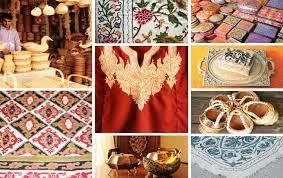
Why in News?
The World Crafts Council International (WCCI) has selected Srinagar to conduct a survey of its craft clusters as a step towards its potential nomination as the World Craft City (WCC) from India this year.
About World Crafts Council International
- The World Crafts Council International (WCCI) is an organization headquartered in Kuwait, dedicated to recognizing and preserving traditional crafts worldwide.
- Founded by Ms. Aileen Osborn Vanderbilt Webb, Ms. Margaret M. Patch, and Smt Kamaladevi Chattopadhyay during the 1st World Crafts Council General Assembly in New York on June 12, 1964.
- Since its inception, the World Crafts Council AISBL has held consultative status with UNESCO for many years.
- Objective: The primary objective of the World Crafts Council AISBL is to enhance the status of crafts in cultural and economic spheres.
- Aim: It aims to promote fellowship among craftspeople by providing encouragement, assistance, and advice.
- The organization fosters cultural exchange through conferences, international visits, research studies, lectures, workshops, exhibitions, and other activities.
Key facts about the World Craft City Programme
- Launched in 2014 by the World Crafts Council AISBL (WCC-International), the World Craft City Programme recognizes the crucial role of local authorities, craftspeople, and communities in global cultural, economic, and social development.
- It establishes a vibrant network of craft cities worldwide, aligning with the principles of the creative economy.
- The programme responds to the growing recognition of the significant contributions made by local entities to multifaceted development.
- India's craft cities Jaipur (Rajasthan), Mamallapuram (Tamil Nadu), and Mysore have already been designated as part of this initiative.
Key facts about Kashmir Craft
- Kashmir's craft traditions draw influence from Central Asian countries, which are also represented within the WCC.
- Inclusion in the WCC list will spotlight Srinagar's rich craft heritage and showcase centuries-old techniques on the global stage.
2550th Mahaveer Nirvan Mahotsav
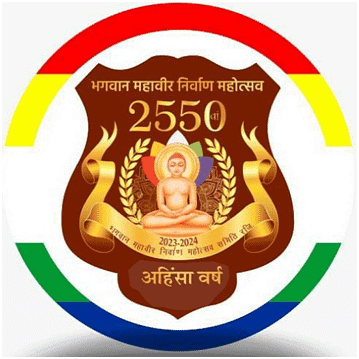
Why in News?
The Prime Minister inaugurated the 2550th Bhagwan Mahavir Nirvan Mahotsav on the occasion of Mahavir Jayanti.
About Vardhaman Mahavir
Description
- Birth: Born in 540 B.C.
- Birthplace: Kundagrama village near Vaishali.
- Family Background: Belonged to the Jnatrika clan; his father Siddharta was the head of the Jnathrika Kshatriya clan, and his mother Trishala was a sister of Chetaka, the king of Vaishali.
- Renunciation: Renounced home at the age of 30 to become an ascetic.
- Spiritual Practice: Practiced austerity for 12 years.
- Attainment of Kaivalya: Achieved the highest spiritual knowledge, Kaivalya (conquering misery and happiness), at the age of 42.
- First Sermon: Delivered his first sermon at Pava.
- Symbol: Associated with the symbol of a Lion.
- Missions: Traveled extensively to regions including Koshala, Magadha, Mithila, Champa, etc.
- Passing Away: Passed away at the age of 72 in 468 B.C. at Pavapuri in Bihar.
- Legacy: Founded Jainism as known today and contributed significant teachings and principles to the religion.
Everything you need to know about Jainism
- Description
- Origin: Jainism gained prominence in the 6th century B.C. when Lord Mahavira propagated the religion.
- Founder: Lord Mahavira, the 24th Tirthankara, is the central figure.
- Tirthankaras: Jainism acknowledges 24 Tirthankaras or great teachers, with Rishabhanatha being the first and Mahavira the last.
- Main Principles: Jainism emphasizes the Three Jewels or Triratna: Right Faith (Samyakdarshana), Right Knowledge (Samyakjnana), and Right Conduct (Samyakcharita).
- Five Doctrines: Ahimsa (non-violence), Satya (truthfulness), Asteya (non-stealing), Aparigraha (non-attachment), and Brahmacharya (chastity) form the fundamental principles of Jainism.
- Concept of God: Jainism does not adhere to the concept of a creator God but believes in liberated souls (Siddhas) who have attained spiritual perfection.
- Major Doctrines: Anekantavada (non-absolutism) and Syadvada (conditional truth) are core Jain doctrines.
- Sects/Schools: Jainism is divided into two major sects: Digambara (sky-clad) and Svetambara (white-clad).
- Spread: Jainism spread into regions where Brahmanical influence was weak and received patronage from rulers like Chandragupta Maurya.
- Literature: Jain literature includes Agama (canonical) texts and non-agama works such as the Acaranga Sutra.
- Architecture: Notable Jain architecture in India includes temples, caves, statues, and ornamental pillars, exemplifying intricate craftsmanship and religious symbolism.
- Jain Councils: Two significant Jain councils were held at Pataliputra and Vallabhi for compiling and preserving Jain scriptures.
- Difference from Buddhism: Jainism differs from Buddhism in its acknowledgment of a permanent self (atman), acceptance of the varna system, belief in the soul (jiva), and advocacy of extreme asceticism.
- Thoughts on Rebirth: Jainism teaches the doctrine of rebirth (samsara) based on karma, with souls cyclically transmigrating through different life forms.
|
38 videos|5258 docs|1111 tests
|
FAQs on History, Art & Culture: May 2024 UPSC Current Affairs - Current Affairs & Hindu Analysis: Daily, Weekly & Monthly
| 1. What is the significance of the Jallianwala Bagh Massacre Compensation in relation to racial bias? |  |
| 2. How does Hoysala’s Sri Madhava Perumal Temple reveal a trade route? |  |
| 3. What was the significance of the Vaikom Satyagraha and how is it being commemorated on its centenary? |  |
| 4. What are the historical and cultural significance of the Ahobilam Temple? |  |
| 5. How have the Rakhigarhi findings been incorporated into NCERT books and why is this important? |  |





















